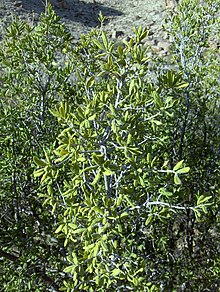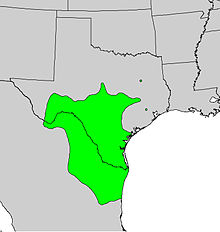Diospyros texana
| Diospyros texana | |
|---|---|
 |
|
| Scientific classification | |
| Kingdom: | Plantae |
| (unranked): | Angiosperms |
| (unranked): | Eudicots |
| (unranked): | Asterids |
| Order: | Ericales |
| Family: | Ebenaceae |
| Genus: | Diospyros |
| Species: | D. texana |
| Binomial name | |
|
Diospyros texana Scheele |
|
 |
|
| Natural range | |
Diospyros texana is a species of persimmon that is native to central, south and west Texas and southwest Oklahoma in the United States, and eastern Chihuahua, Coahuila, Nuevo León, and Tamaulipas in northeastern Mexico. Common names include Texas persimmon, Mexican persimmon and the more ambiguous "". It is known in Spanish as chapote, chapote manzano, or chapote prieto, all of which are derived from the Nahuatl word tzapotl. That word also refers to several other fruit-bearing trees.
Diospyros texana is a multi-trunked small tree or large shrub with a lifespan of 30 to 50 years. It usually grows to 3 m (9.8 ft) in height, but can reach 12 m (39 ft) on good sites. The bark is smooth and light reddish gray and peels away from mature trees to reveal shades of pink, white, and gray on the trunk.
The sclerophyllus leaves are obovate, dark green, 2–5 cm (0.79–1.97 in) long and 1–3 cm (0.39–1.18 in) wide. Apexes are obtuse to emarginate. Upper surfaces are glossy while lower surfaces are covered in fine hairs and lack basilaminar glands. Leaves are attached to 0.1–0.5 cm (0.039–0.197 in) petioles. Trees are deciduous in the north of their range and become evergreen further south.
Diospyros texana is dioecious (separate male and female trees) and produces flowers starting in March or April. The flowers are white, urn shaped, and 0.8–1.6 cm (0.31–0.63 in) wide. They have five sepals, five petals, 16 stamens, and four styles. Flowers are solitary or form on cymes of two to three.
...
Wikipedia
